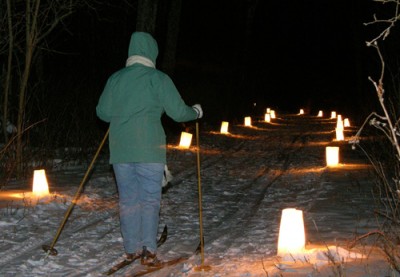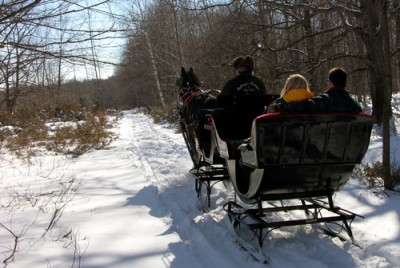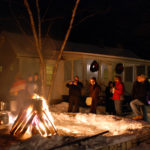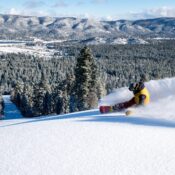“We go through a lot of Band-Aids,” jokes Cy Turnbladh, artist, entrepreneur, and owner of Hands On Art Studio in scenic Door County, Wisconsin. For a nominal fee, visitors can spend the day in Turnbladh’s quarry of workshops, dabbling in paint, fusing glass, throwing pots, or building elaborate metal sculptures. “The possibilities are endless,” says Turnbladh, whose staff wanders the 8,000 square feet of gallery space, fetching supplies and offering advice. Since Hands On Art Studio also is home to a growing collection of rescued animals, cats snooze on shelves while larger wildlife—all appropriately named—are relegated to the grounds outside. Among them: Salvador Dali Llama and Vincent Van Goat.
Turnbladh recently winterized his art compound to boost its attraction as a cozy place to spend an autumn or winter afternoon. He describes Door County as a doers’ destination where guests “can experience art, not just buy it.” The peninsula’s evolution from a warm-weather getaway to a year-round playground is gaining momentum. Rather than hunkering down and waiting for the thaw, residents such as Turnbladh are creating new reasons to beckon guests north to “explore the Door,” as their slogan invites. Roughly two-thirds of the region’s tourists still visit between early May and late October, but the shoulder seasons of winter and spring are becoming increasingly popular.

“You don’t go through Door County,” explains a local merchant, “you go to Door County.” A look at the Wisconsin map underscores his point. The 70-mile Door County Peninsula juts north until it runs out of land and disappears in the swirling water where Green Bay meets Lake Michigan. Early French explorers were so intimidated by the choppy passage between the peninsula’s tip and nearby Washington Island that they called it Port des Morts, or Door to Death. Later, settlers wisely dropped the “death” but held onto the Door.
A ferry service now links Door County with Washington Island, giving visitors one more option to consider when deciding where to go and what to see. The choices and the crowds diminish after the middle of October when fall foliage fades, traffic thins, and some venues close for the season. Getting a table at Al Johnson’s popular Swedish restaurant becomes easier, and the waitresses have time to explain why the goats are on the restaurant’s sod roof (to trim the grass, of course) and what’s so special about Swedish pancakes (they’re square and sprinkled with lingonberries).
Of the county’s 100 art galleries and museums, enough are open to prompt tourists to wander the string of villages, talk to the locals, and hear the quirky stories behind the towns’ names. There’s Carlsville, once spelled “Karlsville” and named for the large number of male residents (six!) with the first name of Karl. Then there’s Egg Harbor, whose name dates back to 1825 when a trade flotilla put down anchor and a food fight broke out among the landing party. This resulted in eggshells covering the pristine beach. The town of Ephraim—a biblical word meaning “fruitful,” appropriate since tart cherries grow by the bushels—was settled by Norwegian Moravians and still follows Moravian law that insists all buildings be painted white.

During “high season,” at least 10 restaurants in the various villages host outdoor fish boils. By November that number shrinks, but the tradition continues on Friday nights at the century-old White Gull Inn. The cooler weather and early sunset (around 4 p.m. in December) add to the fun because dinner guests huddle outside to form a ring around a huge steaming cauldron. The pot, filled with chunks of fresh whitefish and small red potatoes, is brought to a boil over an open fire. When the fish oils rise to the surface, the Master Boiler tosses a small amount of kerosene under the pot. The burst of flames causes the oils to spill over the sides and leaves the fish perfectly cooked and ready to serve.
Reservations for the fish boil are required in the summer months but off-season guests are likely to claim a spot around the cauldron without advance notice. The same holds true for securing rooms at one of the dozens of inns that stay open after October. Some accommodations are especially welcoming during the six-month stretch that innkeepers call “the quiet season.” At the Blacksmith Inn on the Shore, each room has a postcard view of Lake Michigan, a fireplace, and is furnished with authentic antiques. “My wife scoured the country for the furniture,” says innkeeper Bryan Nelson, who bought the house and its next-door smithy 13 years ago as “a work in progress.”
At least half of the guests at the Blacksmith Inn are repeat visitors who often request their favorite rooms year after year. For newcomers who ask for suggestions on how best to spend their limited time, Bryan has a ready list of activities based on the season. He recommends that warm weather visitors consider a bike ride to the Cana Island lighthouse, a two-hour sail on the schooner Friendly, or an outdoor jazz concert. When the temperatures dip, there are candlelight ski treks, sleigh rides through the woods, and cooking classes at The Savory Spoon. However they customize their itineraries, guests usually voice the same complaint when they leave, according to Bryan. “I often hear people say, ‘We simply ran out of time.’ ”

Get in line
Door County is football country, and the Green Bay Packers have been the “home team” for 90 years. The Packers open their season on September 13, but if you’re thinking about adding football to your vacation itinerary, get in line. Historic Lambeau Field, home of the Packers, has been sold out since 1960 and has 57,000 names on its ticket waiting list. The team is owned by fans who turn out in record numbers to cheer their 12-time national champions. Average wait for season tickets: 30 years.
Take a number
Did you know that Door County has:
- 300 miles of shoreline
- 10 historic lighthouses
- 42 outlying islands
- 5 state parks
- 2,000 acres of cherry orchards
Cherries for all seasons
Door County orchards typically produce 13 million pounds of tart cherries a year, which means visitors can stock up on cherry wine, salsa, BBQ sauce, jams, butter, juice … and the list goes on and on. Most restaurants and inns keep a ready supply of dried cherries on hand so they can offer their “specialties of the house” year-round.
The recipes for Cherry Almond Scones and Cherry Oatmeal Cookies are from the Blacksmith Inn on the Shore.
All images courtesy of Door County Visitor Bureau, doorcounty.com
Become a Saturday Evening Post member and enjoy unlimited access. Subscribe now















